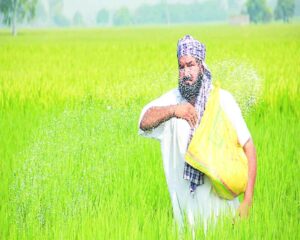The flawed subsidy and pricing policy followed by governments for years has led to excessive use of urea and a deterioration in soil health

The subsidy is given directly to the farmers even as the manufacturers charge consumers a price that fully covers the cost of supply.
For over a decade, Indian agriculture has been grappling with an imbalance in fertiliser use involving excessive use of nitrogen or ‘N’ vis-à-vis phosphate or ‘P’ and potash or ‘K’ even as the present NPK use ratio at 6.7:2.4:1 (against the desired 4:2:1) is tilted in favour of ‘N’. This, in turn, has led to a decline in crop yield, deterioration in soil health and adverse impact on the environment.
The imbalance has persisted despite Prime Minister Narendra Modi urging farmers to curb the use of urea (the predominant source of ‘N’ supply) by 50 percent, issuing soil health cards (SHCs) that guide farmers to use nutrients in sync with the requirements of the soil and mandating the use of neem coated urea.
Apart from urea, though there are 22 grades of fertilisers being the source of ‘P’ and ‘K’ (call them non-urea fertilisers), di-ammonium phosphate (DAP) and muriate of potash (MOP) are the most widely used.
The maximum retail price (MRP) of urea is controlled by the Centre at a low level and is unrelated to the cost of production and distribution which are higher. The excess amount is reimbursed to the manufacturers via the subsidy on a ‘unit-specific’ basis under the New Pricing Scheme or NPS. This price has remained unchanged – the current price is the same as it was in 2002, as all cost escalations are absorbed by increasing the subsidy.
For non-urea fertilisers, the Centre fixes a ‘uniform’ subsidy on a per-nutrient basis for all manufacturers under the nutrient-based subsidy (NBS) scheme. The manufacturers are free to fix the MRP but are expected to reflect the subsidy. Unlike urea, where increasing subsidy helps in keeping MRP immune to cost hikes, the government generally does not adjust subsidies on P&K fertilisers. This leads to price increases as costs escalate.
When the MRP of urea stays low for extended periods and those of non-urea fertilisers are prone to increase, farmers are bound to use more of the former and less of the latter, leading to imbalance. Since 2021-22, the Modi government has substantially hiked subsidies on P&K fertilisers to offset the increase in their cost (due to the Ukraine war), as is the case with urea. The comparative equation remains unchanged even as DAP continues to sell at 4.5 times the price of urea.
P&K fertilisers face discrimination in other respects too such as freight and gas allocation. While freight cost is reimbursed for primary movement (from the factory to rail-head) for P&K fertilisers, on urea, secondary movement up to the retail point is also considered. Also, urea producers get priority in the allocation of domestic gas, while non-urea manufacturers are left to fend for themselves.
One way to address the imbalance is to align the policy dispensation for urea with non-urea fertilisers in its entirety. This is not practical. If the political brass was serious, it would not have allowed discrimination in the first place.
The way forward is direct benefit transfer (DBT). Under it, the subsidy is given directly to the farmers even as the manufacturers charge consumers a price that fully covers the cost of supply (or market-determined price). With the subsidy transferred, say on a per acre basis, into the bank account, a farmer can use it to buy appropriate fertilisers as determined by soil analysis. This will curb the excessive use of urea and reduce the imbalance in NPK use.
Moreover, when manufacturers are free to sell at a market-based price in a decontrolled environment, other benefits will accrue by way of eliminating diversion, lowering the cost of supply and developing customised solutions to meet farmers’ diverse needs. With MRP being a mere one-tenth of the cost of supplying urea, under the present regime, diversion is rampant, even to neighbouring countries such as Nepal and Bangladesh.
The government’s stance is ‘DBT is already in place’ albeit since 2018-19. This is factually incorrect.
Prior to March 2018, manufacturers were getting 95 percent of the subsidy on urea (85 percent in case of non-urea fertilisers) ‘on receipt of material at a district’s railhead point or approved godown’ and the balance 5/15 percent on confirmation of sales to farmers by states. From March 2018, disbursal of subsidy was made conditional upon actual sales to farmers and these getting registered on point-of-sale (PoS) machines after undergoing Aadhaar authentication.
But subsidy continues to be routed through manufacturers, so, it is an indirect transfer. Now, the Centre is planning to conduct pilots in some districts on a modified version of the DBT. Here, the intent is to link the sale of subsidised fertiliser to farmers’ land holdings and the crop grown. It doesn’t change the nature of the transfer.
Thus, a genuine direct benefit transfer of fertilisers is miles away.
UTTAM GUPTA is a policy analyst. Views are personal and do not represent the stand of this publication.
https://www.moneycontrol.com/news/opinion/dbt-is-the-way-forward-for-balanced-fertiliser-use-9727961.html